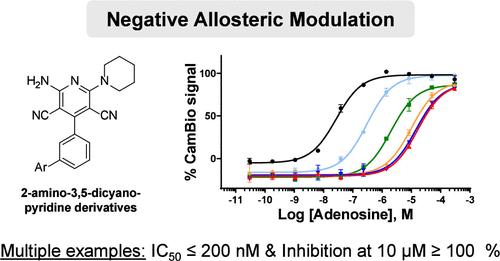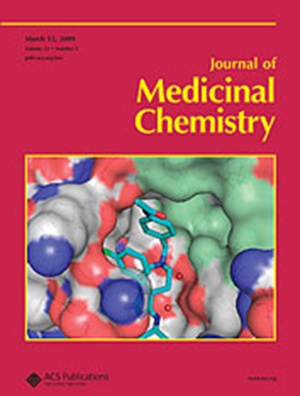Discovery of the First Efficacious Adenosine 2A Receptor Negative Allosteric Modulators for High Adenosine Cancer Immunotherapies
IF 6.8
1区 医学
Q1 CHEMISTRY, MEDICINAL
引用次数: 0
Abstract
Inhibition of the adenosine 2A receptor (A2AR) is recognized as a promising immunotherapeutic strategy but is challenged by the ubiquity of A2AR function in the immune system. To develop a safe yet efficacious immunotherapy, the discovery of a novel negative allosteric modulator (NAM) was preferred. Leveraging an in-house, sensitive, high-throughput screening cellular assay, novel A2AR NAM scaffolds were identified, followed by an extensive structure–activity relationship (SAR) study, leading to the discovery of potent 2-amino-3,5-dicyanopyridine derivatives. The allosteric mode of action of active compounds was confirmed by progressive fold-shift assay, nonlinearity of the Schild plot analysis, biophysical measurements, and retained satisfactory potencies in high-adenosine concentrations. Further correlation of A2AR engagement and downstream signaling was done in a human blood translational assay, clearly showcasing the potential of A2AR allosteric modulation as a novel approach for efficient and safer cancer immunotherapies.

求助全文
约1分钟内获得全文
求助全文
来源期刊

Journal of Medicinal Chemistry
医学-医药化学
CiteScore
4.00
自引率
11.00%
发文量
804
审稿时长
1.9 months
期刊介绍:
The Journal of Medicinal Chemistry is a prestigious biweekly peer-reviewed publication that focuses on the multifaceted field of medicinal chemistry. Since its inception in 1959 as the Journal of Medicinal and Pharmaceutical Chemistry, it has evolved to become a cornerstone in the dissemination of research findings related to the design, synthesis, and development of therapeutic agents.
The Journal of Medicinal Chemistry is recognized for its significant impact in the scientific community, as evidenced by its 2022 impact factor of 7.3. This metric reflects the journal's influence and the importance of its content in shaping the future of drug discovery and development. The journal serves as a vital resource for chemists, pharmacologists, and other researchers interested in the molecular mechanisms of drug action and the optimization of therapeutic compounds.
 求助内容:
求助内容: 应助结果提醒方式:
应助结果提醒方式:


